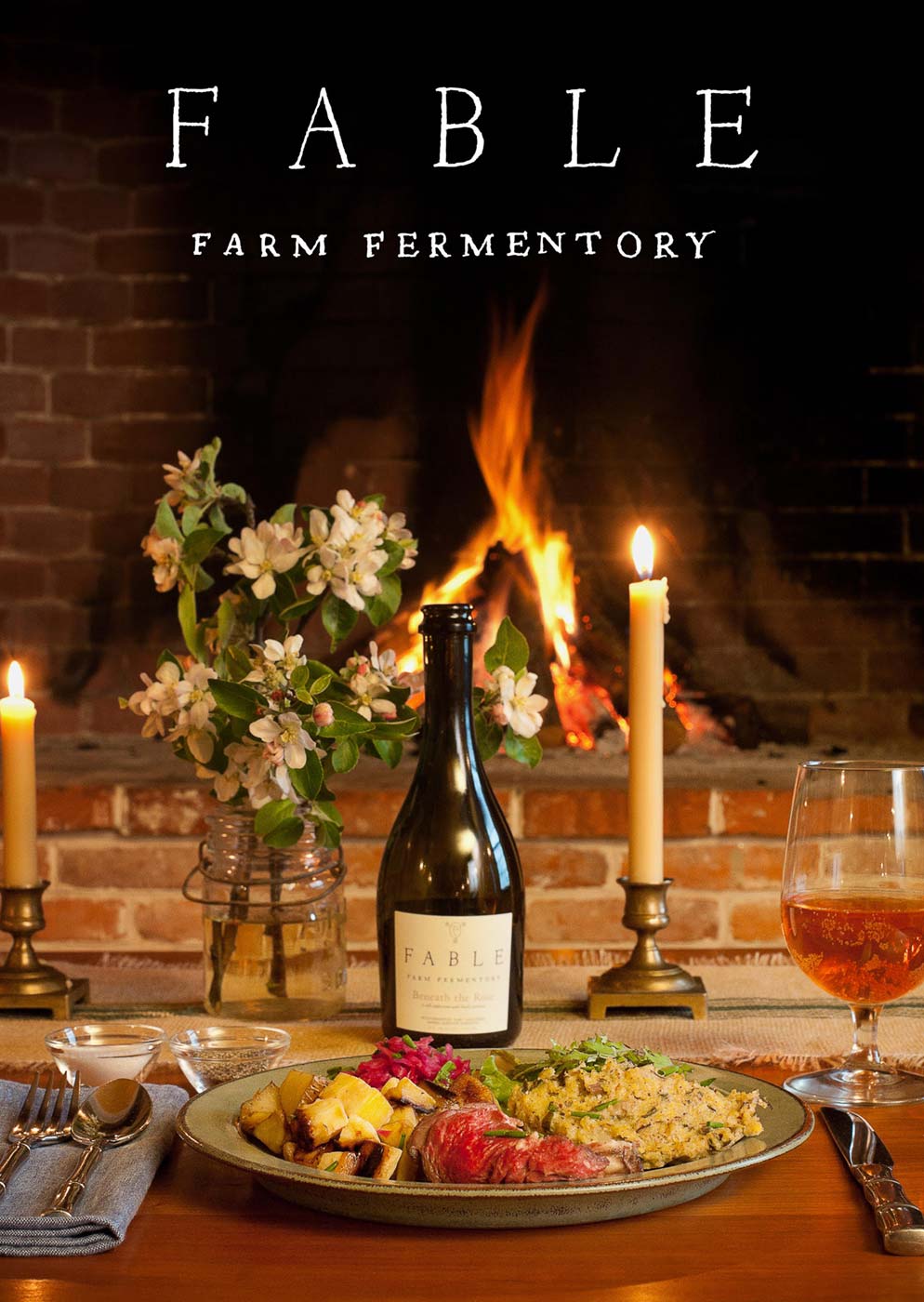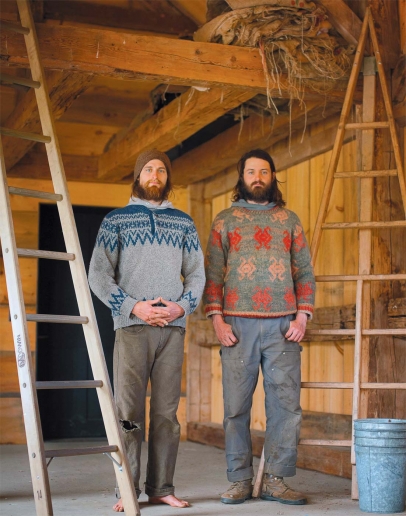Fable Farm Fermentory: Following the Spirit of the Apple
Brothers Chris and Jon Piana are dreamers who speak with a mystical passion that reflects their deep reverence for the earth. As farmers, they are literally rooted in this land—the lush, rolling hills of Barnard in central Vermont—where they have lived since 2008. But in 2013, the “spirit of the apple” led Jon and Chris to transition from farming annual vegetables to nurturing perennial fruit trees, grapevines, and berry bushes. The decision to produce natural wines from these fruits underscores their commitment to stewarding this land in perpetuity. “We wanted to create a liquid asset with a longer shelf life than vegetables, and that led us to build the fermentory,” Jon explains. “By fermenting apples and grapes into wine, we are preserving the fruits of the Earth and our labor through time, to be cherished by more people.” Fable Farm grows, gleans, ferments, and ages a medley of fruits, tree saps, and honey. Jon calls the potential “limitless” for what he can craft from these elements.
Fable Farm belongs to a collective of dairy, livestock, and fruit enterprises based on the historic 450-acre Clark Farm, preserved through the Vermont Land Trust. In 2013, Joseph Morel, owner of Eastman Farm, which raises livestock, resurrected an 18th-century barn from Rumney, New Hampshire; this mustard-hued structure has become the heart of the collective and Fable Farm, its soul. Fable Farm has evolved into a fermentory, a venue, and a culinary company that prepares farm-grown food and drink for its Feast & Field gatherings and other special events.
“We’ve been foraging wild apples and making sparkling cider on tap for gatherings since 2009,” Jon says. “Th e cider itself is a blending of community apples, and people from all walks of life gather to drink and be merry with each other.”
Jon manages the fermentory while Chris oversees the farm. The brothers and their dedicated team have established an orchard adjacent to the ancient apple trees that stand proud on a hillside above the barn. They’ve planted more than 200 English and French cider apple trees along with a variety of complementary fruits including pears, currants, elderberries, and Schisandra berry, aka the five-flavor berry. Across the road are blueberries, raspberries, and the vineyard. “It’s been a real education, and we’re humbly learning that it takes more to grow trees than we thought,” Jon admits.
Chris and Jon planted a two-acre vineyard in 2019; they will harvest their first grapes in the fall of 2022. “We buy cold-hardy native rootstock from Andy Farmer at Northeastern Vines in West Pawlet,” Jon says. “As we prune to create good sap flow and bring in light, we’re developing a relationship with each vine and shepherding it to do what it does best: produce abundant, healthy fruit. The same holds true with our fruit trees and berry bushes.”

Burlap coffee bean bags overflowing with wild cider apples harvested by the Fable Farm crew.
In 2013, the “spirit of the apple” led Jon and Chris to transition from farming annual vegetables to nurturing perennial fruit trees, grapevines, and berry bushes.
Cold-hardy grapes seem to thrive in central Vermont, and La Garagista’s vineyard is located on the next chain of hills over. “Deirdre Heekin and Caleb Barber have been hugely helpful as we established our vineyard. They’re allies, sharing resources and letting us bounce ideas off them.”
Jon has nurtured a lifelong passion for plants and brings an herbalist’s perspective to fermentation and winemaking. He believes that making wine integrates science, spirituality, and art. “Going back in the history of wine, herbs and other fruits would be blended in because wine is a perfect delivery method for medicinals. I see the full beneficial bacterial matrix of medicine in all these plants.”
While they wait for their own orchard and vineyard to produce fruit, the team at Fable purchases grapes from other Vermont vineyards and harvests wild apples by the truckload from August through November. “We supplement with fresh apple juice from Todd Parlo at Walden Heights Orchard in the Northeast Kingdom. He has incredible diversity in his juice, and we’re grateful for all that he teaches us.” All the fruit is pressed at Fable, and the juice is fermented in stainless steel tanks, oak barrels that once held French wine or bourbon, or glass demijohns. Each fermenting vessel lends a unique character to the resulting cider wine. The wine then ages to dryness, a gentle process that rewards Jon’s patience.
In the United States, cider is considered juice whereas in the rest of the world, cider is treated as wine. Jon explains, “When describing our products, we use the words ‘cider’ and ‘wine’ interchangeably. Wine is fermented fruit, generally grapes. In our case, we’re making wine from fermented apples.”
In the fermentory’s barrel-vaulted cave, Jon creates up to 12 varieties of wine and mead, blending combinations of cider and pressed juice from other fruits. Fable Farm wines have a relatively low alcohol content, making them sessionable beverages that pair beautifully with a range of food or are easy to enjoy on their own. As living, unfiltered, “raw” wines, the natural probiotics aid digestion while the tiny prickly bubbles of the sparkling wines cleanse the palate and leave you feeling refreshed, not dulled.
Jon explains the primaries. “Still Point, Fluxion, and Emanation, our only straightup ciders, are flagship products. The cider for Emanation goes straight from the stainless steel tank into bottles, with no aging. Fluxion is barrel-aged cider with a bit of maple syrup added to create carbonation. Still Point is the same cider but bottled as still, with no carbonation. Leo is a cider that’s steeped and cofermented with pressed white grape skins that provide residual sugars, tannins, and acids. Vinous Venus uses the same process but incorporates the pressed skins of red grapes that add color and depth of flavor. Jalu is a blend of apple and grape wines, and Rosa is a black currant–infused apple wine. For Betula, our mead, we tap birch trees and blend that clear sap with honey and sumac berries to produce an ethereal, translucent peach-hued liquid.”
Jon looks down the length of the cave, where cases of bottle-conditioned wines line the cool cement and brick walls, dating back to the first vintage in 2011. “This cave embodies the notion of a liquid asset,” he reflects. “This is our bank, our treasure vault. I can blend any of our juices and fruits with anything. I can make elixirs, shrubs, vinegars, and spritzers. I love this freedom to create and to not feel constricted by rules of how wine should be made. Instead, I dream of how wine could be made.”
SUGGESTED PAIRINGS FOR FABLE FARM FERMENTORY CIDER WINES
 As Fable Farm cider wine has higher acidity, and mostly sparkling, it makes for fun pairings. Our wines/ciders complement a broad range of foods, from all manner of rustic farm dishes to fresh green salads, fried chicken, sourdough toast with Ploughgate sea salt butter, oysters, pizza, and popcorn. However, here are some specific suggested pairings for each variety.
As Fable Farm cider wine has higher acidity, and mostly sparkling, it makes for fun pairings. Our wines/ciders complement a broad range of foods, from all manner of rustic farm dishes to fresh green salads, fried chicken, sourdough toast with Ploughgate sea salt butter, oysters, pizza, and popcorn. However, here are some specific suggested pairings for each variety.
Emanation (sparkling apple wine): oysters, lobster, pesto pasta, smoked cheeses/alpine cheeses (Gruyère, Emmentaler, Comté)
Fluxion (sparkling apple wine): Parmesan, Bayley Hazen Blue, Vermont Shepherd Invierno. Corn/clam/fish chowder, grilled cheese, any creamy/ cheesy pasta, canned/smoked fish
Still Point (non-carbonated apple wine): Brie, cheddar, gouda, smoked cheeses. Creamy/cheesy pasta, chicken and dumplings, baked Brie, canned/smoked fish
Rosa (sparkling black currant apple wine): routine, oysters, fried chicken, warm salads/sautéed greens, sharp cheeses, roast duck, cheesy pizza
Petulant mead: Thanksgiving meal (the ultimate pairing!), Harrison, Bayley Hazen, triple creme cheese, aged cheddar, Mediterranean food, fried/beer-battered fish
Leo (sparkling apple and white grape wine): bouillabaisse, goat cheese/soft crumble cheeses, feta, routine, oysters, Mexican food, roasted “game” meat, hummus/flatbread, fried chicken
Jalu (sparkling apple and grape wine): risotto, meat lovers pizza, barbacoa tacos, aged cheeses, salami, sauerkraut, Bolognese sauce, oysters, roasted veal/pork/beef
Jalu Still (still apple and grape wine): roasted veal/pork/beef, osso buco, corn on the cob, salami/ prosciutto and other cured meats, Sunday gravy
Vinous Venus (sparkling apple and red grape wine): oysters, roasted veal/pork/beef, fried green tomatoes, French onion soup, soft funky cheeses (Harbison, triple crème, bijou), all charcuterie, fried chicken





